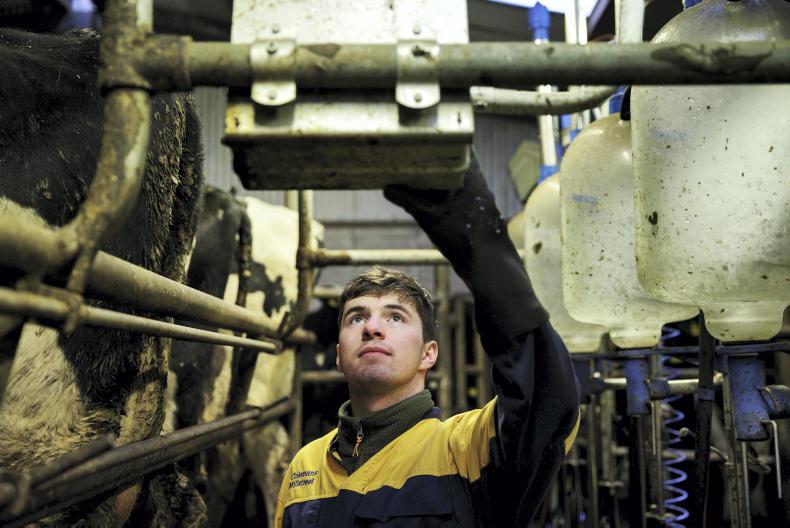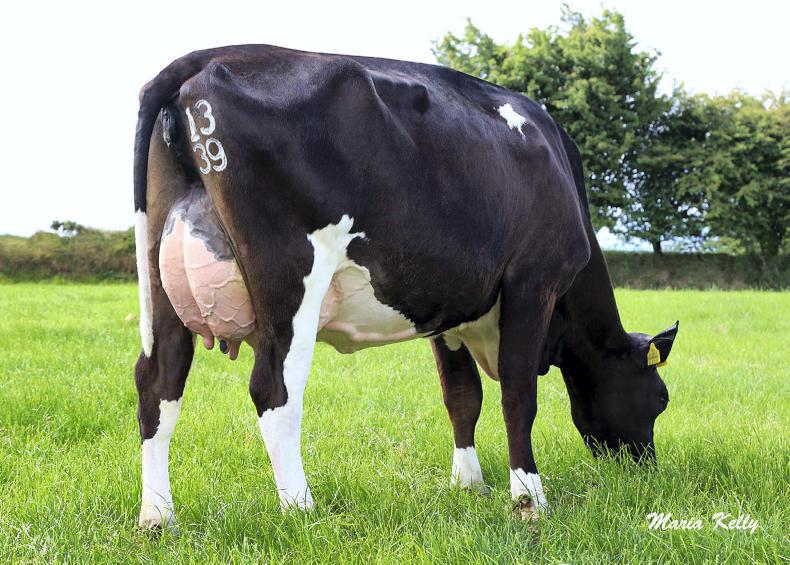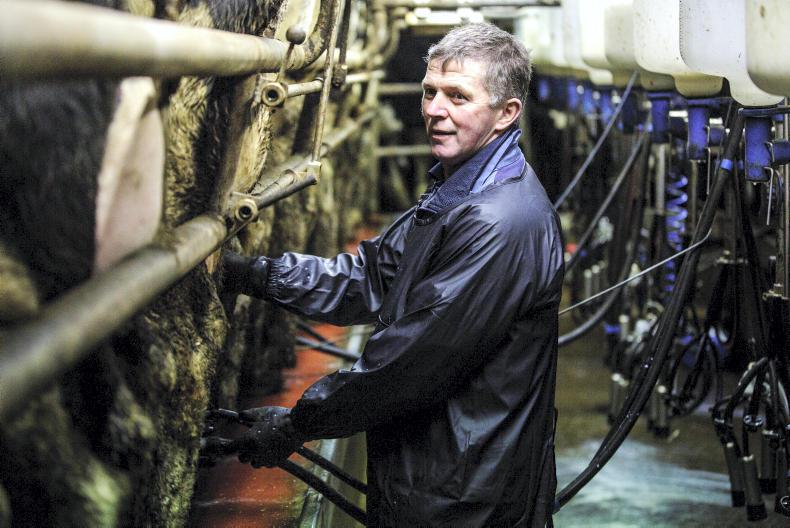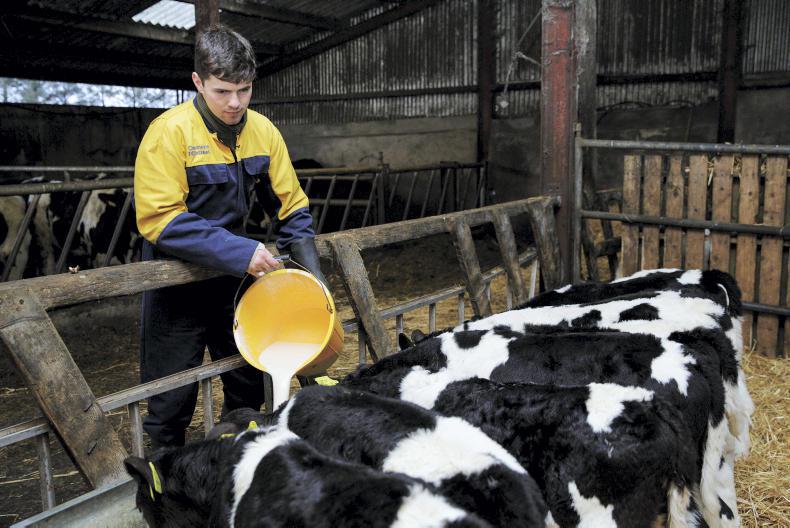Situated in the heart of dairy country in north Cork, the Radney Holstein herd has made serious strides in recent years in becoming one of the most recognised herd names in the breed. Run by Henry O’Keeffe, his son Liam, and family, the herd now milks 90 cows with a clear focus on combining production with type traits.
The biggest turning point was back in 1987, when the herd Henry’s father Mossy had built up got depopulated.
“I decided to establish a pedigree herd on re-stocking. They came from the Ardrahan herd in Kanturk mostly; they were the best ones that came. We bought about 40 heifers that time and we built up from there,” Henry said.
“We calve down about 115 a year and milk around 90. We’d generally sell off any surplus stock as freshly calved heifers. Last year the herd averaged 8,817kg of 3.99% fat and 3.76% protein – 683kg milk solids.”
This production is being met with a moderate feed bill, with cows eating 1.1t of concentrates per year.

Liam O'Keeffe milking the Radney Holstein herd. \ Donal O'Leary
“We give them beet and silage when they’re inside, and they’d eat over a tonne of nuts in the year. We got a zero grazer two years ago as well so we get more grass into them that way, and it’s a good help for both ends of the year also. It leaves the fields in excellent condition. New fresh spring grass is then widely available to the cows when they go out to graze. Last year we saw protein rise massively when it came to the grazing after the zero grazer.”
While production has being a key driver in the herd’s development, cow selection by type has also led to a very phenotypically correct herd. In all, 70% of the herd’s cows are classified VG or higher. Of these, 19 classify EX. This helped the herd top the Cork division of the spring-calving herds competition in 2017.
"You’re always looking to keep the solids up but you want volume up as well. We like solids and we like good udders and good feet, good functional cows with longevity. If a cow is getting too extreme, we’d cross her back to the British Friesian.
"The herd policy is to select functional cows, and then try to get the best performance from those cows. Classification and milk recording are handy tools to aid breeding and identify functionality. Cows that are long lasting means there is surplus breeding stock available for sale.”
Backbone
The backbone to the herd’s recent success is made up of family lines that have been proven through generations. Four key lines were quickly established – the Odettas, Gerrards, Ostriches and Deborahs.
“The Odettas are the line that really propelled the herd. We want cows that last and the foundation cow for this family had 16 progeny, Radney Seal Odetta EX90. Her EX93-classified daughter is still going strong in her 16th lactation while her granddaughter Radney QUR Odetta EX93 is the standout cow in the herd.”

A member of the Odetta family in the Radney herd.
QUR Odetta is the dam of well-known AI bull Radney Levi 5 (YRY) in Eurogene, as well as being the grand dam of Radney Steve ET (FR4098) in Dovea. Dam of Radney Steve is a full-sister to Levi 5, with Henry expressing keen hopes for this young cow that has a projected second-lactation yield of 9,732kg, of which 765kg are milk solids.
“Tom Baker of Eurogene was the first to pick up on the Odetta family when he purchased YRD (Radney Desmund 14) which highlighted the herd a bit more. We’ve kept most females from this line,with Levi 5’s mother giving eight daughters to the herd. Around one-third of the herd are Odettas at this stage.
“The Gerrard line also bred an AI bull that went to ABS, Radney Rock. While the Deborahs carry some very high-protein cows, they make up 16 members of the current herd. Radney OOK Deborah EX90 from this line gave 9,080kg of 4.49% fat and 3.91% protein in her third lactation. A bull from this line, Radney Mill, was purchased by Eurogene this year.”
To ensure only the best breeding females are coming through for future years, and that the breeding of the herd’s top-producing cows is safeguarded, an embryo transfer programme is run routinely.

A full sister to new AI bull Radney Mill. \ Maria Kelly
“We have a closed herd, so are always trying to increase the amount of good females we have both for ourselves and for selling. Radney Steve would’ve been as a result of ET – we got 12 eggs out of his dam again last year.
“Radney Levi 5’s dam, who is currently in her 10th lactation, was also flushed last year and we got eight calves on the ground this spring. We also put some heifers in calf to sexed semen this year and got on well – 55% conception rate with the sexed semen straws. We put in 23 and got 12 pregnancies out of it.”
Sales
The sales of both bulls and heifers contribute massively to the bottom line in the Radney herd. Although 90 cows are milked, 115 are calved down. This means a further 25 first-calvers can be sold just after calving, as well as allowing for an extra 25 calves to sell.

Henry O'Keeffe milking the Radney Holstein herd. \ Donal O'Leary
“We have more heifers on the ground to sell since 2015 but luckily it’s being met with demand. Heifer sales are a lot of repeat business, but sometimes we may bring freshly calved heifers to local sales.
“The bull trade is again largely based on repeat customers. We sell the ones that won’t make the mark as calves and keep about 30 bulls out of the best dams to sell throughout the year.
“While we sell a lot at home, we also carry some to sales in the spring. Nenagh has been a good sale for us, along with Kanturk, Bandon and Kilmallock.”

Liam O'Keeffe feeding calves. \ Donal O'Leary
Henry’s son Liam is in his final year of Agriculture in Cork Institute of Technology with high hopes that another generation of O’Keeffes will continue to breed the Radney prefix.
“The prospect of Liam returning to the farm is a big positive for the future. It’s a brilliant way of life when you’re happy at it. It’s a lot of work alright but I wouldn’t switch it for anything.”






 This is a subscriber-only article
This is a subscriber-only article











SHARING OPTIONS: